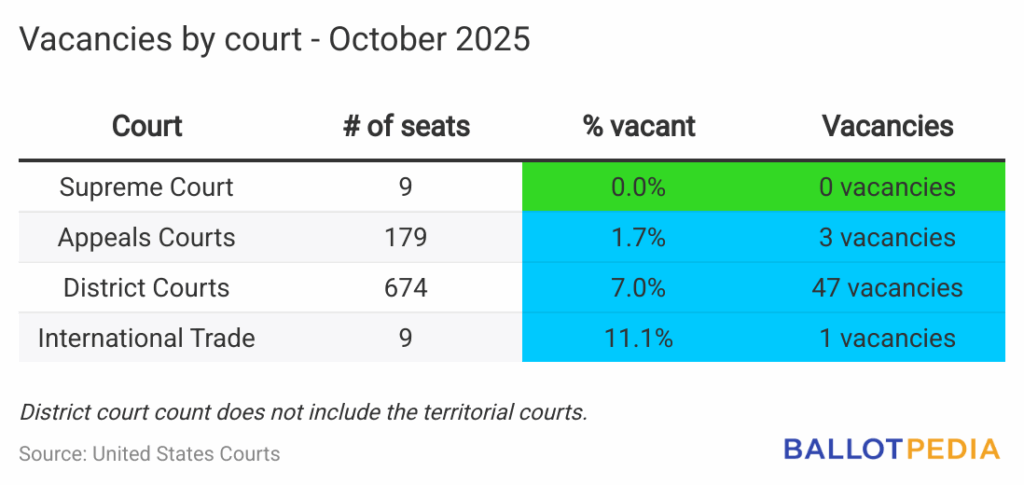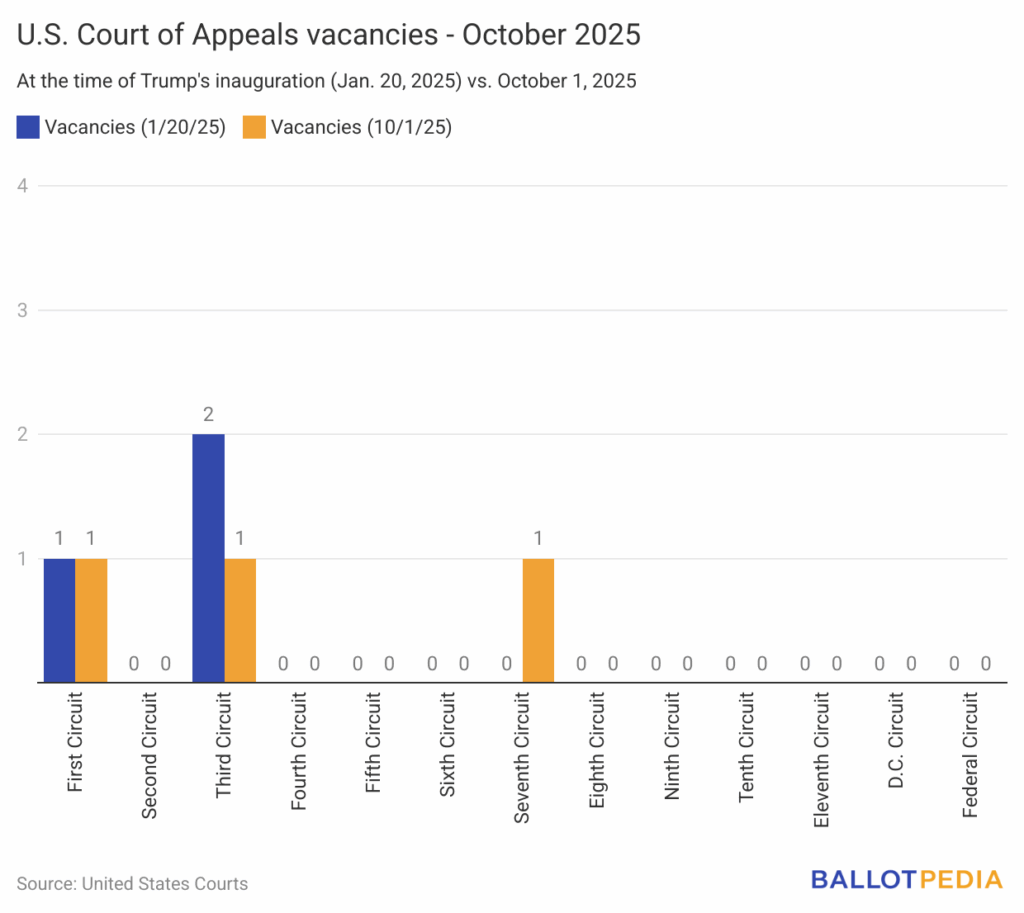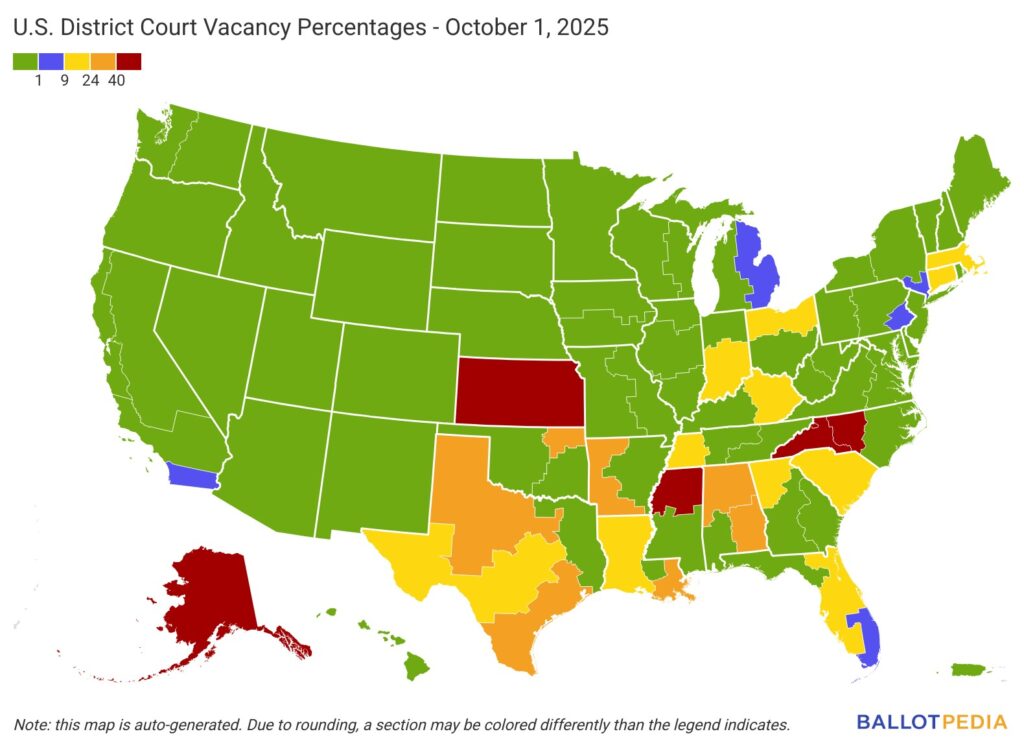Welcome to the Oct. 6 edition of Robe & Gavel, Ballotpedia’s newsletter about the Supreme Court of the United States (SCOTUS) and other judicial happenings around the U.S.
Dear reader, it’s the day we’ve all been waiting for: the first day of the October 2025-2026 SCOTUS term! Thank you for choosing Ballotpedia as your source for SCOTUS news. We are so excited to bring you the latest updates for this new term. Without further ado, let’s gavel in.
Follow Ballotpedia on X and Bluesky or subscribe to the Daily Brew for the latest news and analysis.
We #SCOTUS and you can, too!
Grants
SCOTUS has accepted six new cases to its merits docket since our Sept. 8 issue. To date, the court has agreed to hear 40 cases for the 2025-2026 term. One case was dismissed.
Click the links below to learn more about these cases:
- Trump v. Slaughter originated from the U.S. Court of Appeals for the District of Columbia Circuit.
- Trump v. Cook originated from the U.S. Court of Appeals for the District of Columbia Circuit.
- Exxon Mobil Corp. v. Corporación Cimex, S.A. originated from the U.S. Court of Appeals for the District of Columbia Circuit.
- Havana Docks Corporation v. Royal Caribbean Cruises, Ltd. originated from the U.S. Court of Appeals for the Eleventh Circuit.
- Wolford v. Lopez originated from the U.S. Court of Appeals for the Ninth Circuit.
- Pung v. Isabella County, Michigan originated from the U.S. Court of Appeals for the Sixth Circuit.
Arguments
The Supreme Court will hear six arguments this week. Click here to read more about SCOTUS' current term.
Click the links below to learn more about these cases:
Oct. 6
- Villarreal v. Texas concerns the Sixth Amendment.
- The questions presented: "Whether a trial court abridges the defendant's Sixth Amendment right to counsel by prohibiting the defendant and his counsel from discussing the defendant's testimony during an overnight recess."
- Berk v. Choy concerns whether an affidavit of merit (AOM) is required to bring a complaint of medical malpractice against a practitioner, according to Delaware state law.
- The questions presented: Whether a state law providing that a complaint must be dismissed unless it is accompanied by an expert affidavit may be applied in federal court."
Oct. 7
- Chiles v. Salazar concerns whether Colo. Rev. Stat. § 12-245-224(1)(t)(V) violates the Free Speech Clause of the First Amendment.
- The questions presented: "Whether a law that censors certain conversations between counselors and their clients based on the viewpoints expressed regulates conduct or violates the Free Speech Clause."
- Barrett v. United States concerns the Double Jeopardy Clause of the Fifth Amendment and 18 U.S.C. § 924(c) and (j).
- The questions presented: "1. Whether the Double Jeopardy Clause permits two sentences for an act that violates 18 U.S.C. § 924(c) and§ 924(j), a question that divides seven circuits but about which the Solicitor General and Petitioner agree.
“2. Whether ‘Hobbs Act robbery qualifies as a crime of violence under §924(c) (3)(A), a question left open after’ United States v. Taylor, 596 U.S. 845 (2022). United States v. Stoney, 62 F.4th 108, 113 (3d Cir. 2023). "
Oct. 8
- Bost v. Illinois State Board of Elections concerns whether the petitioners, Michael J. Bost, et al., had Article III standing to bring this case to the Court.
- The questions presented: "The sole question presented here is whether Petitioners, as federal candidates, have pleaded sufficient factual allegations to show Article III standing to challenge state time, place, and manner regulations concerning their federal elections.
- USPS, et al. v. Konan, Lebene concerns the Federal Tort Claims Act.
- The questions presented: "Whether a plaintiff's claim that she and her tenants did not receive mail because Postal Service employees intentionally did not deliver it to a designated address arises out of 'the loss' or 'miscarriage' of letters or postal matter. 28 U.S.C. 2680(b)."
Opinions
SCOTUS has not ruled on any cases since our September 8 edition. The court has not issued rulings in any cases so far this term.
The Federal Vacancy Count
The Federal Vacancy Count tracks vacancies, nominations, and confirmations to all U.S. Article III federal courts in a one-month period. This month’s edition includes nominations, confirmations, and vacancies from Sept. 2 to Oct. 1.
Highlights
- Vacancies: There were four new judicial vacancies since the September 2025 report. There are 51 vacancies out of 870 active Article III judicial positions on courts covered in this report. Including the U.S. Court of Federal Claims and the U.S. territorial courts, 52 of 890 active federal judicial positions are vacant.
- Nominations: There were no new nominations since the September 2025 report.
- Confirmations: There were three new confirmations since the September 2025 report.
Vacancy count for October 1, 2025
A breakdown of the vacancies at each level can be found in the table below. For a more detailed look at the vacancies in the federal courts, click here.

*Though the U.S. territorial courts are named as district courts, they are not Article III courts. They are created in accordance with the power granted under Article IV of the U.S. Constitution. Click here for more information.
New vacancies
Four judges have left active status since the previous vacancy count, creating Article III life-term judicial vacancies. The president nominates individuals to fill Article III judicial position vacancies. Nominations are subject to U.S. Senate confirmation.
- Judge David Godbey assumed senior status on the U.S. District Court for the Northern District of Texas.
- Judge Mitchell Goldberg retired from the U.S. District Court for the Eastern District of Pennsylvania.
- Judge Jane Boyle assumed senior status on the U.S. District Court for the Northern District of Texas.
- Judge Diane Sykes assumed senior status on the U.S. Court of Appeals for the Seventh Circuit.
The following chart tracks the number of vacancies in the U.S. Courts of Appeals from President Donald Trump's (R) inauguration to the date indicated on the chart.

U.S. District Court vacancies
The following map shows the number of vacancies in the U.S. District Courts as of Oct. 1.

New nominations
President Trump announced no new nominations since the previous report.
The president has announced 27 Article III judicial nominations since taking office on Jan. 20, 2025. For more information on the president’s judicial nominees, click here.
New confirmations
As of Oct. 1, the Senate has confirmed eight of President Trump’s judicial nominees—six district court judges and two appeals court judges—since January 2025.
- Maria Lanahan to the U.S. District Court for the Eastern District of Missouri.
- Kyle Dudek to the U.S. District Court for the Middle District of Florida.
- Edward Artau to the U.S. District Court for the Southern District of Florida.
Comparison of Article III judicial appointments over time by president (1981-Present)
- Presidents have made an average of 17 judicial appointments through Oct. 1 of their first year in office.
- President Bill Clinton (D) made the most appointments through four years with 174. President George W. Bush (R) made the fewest through four years with 122.
- President Barack Obama (D) made the most appointments through two years with 134. President W. Bush made the fewest with 54.
- President Obama made the most appointments through one year in office with 45. President W. Bush made the fewest with 22.
Need a daily fix of judicial nomination, confirmation, and vacancy information? Click here for continuing updates on the status of all federal judicial nominees.
Or, keep an eye on this list for updates on federal judicial nominations.
Looking ahead
We’ll be back on Oct. 13 with a new edition of Robe & Gavel. Until then, gaveling out!
Contributions
Myj Saintyl compiled and edited this newsletter, with contributions from Sam Post and Ellie Mikus.

